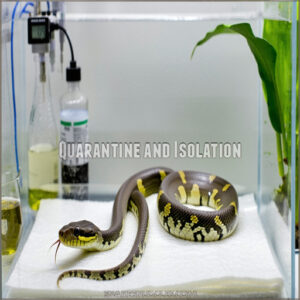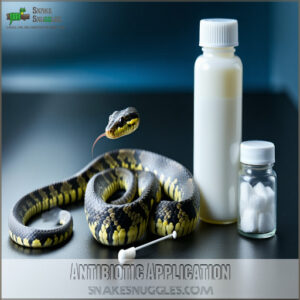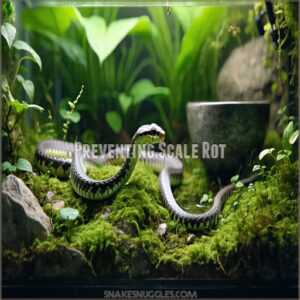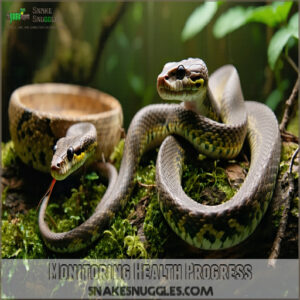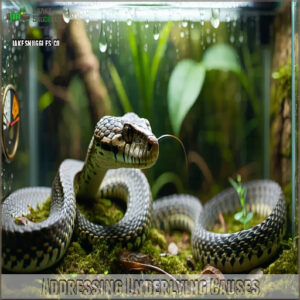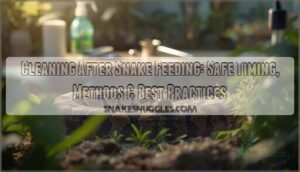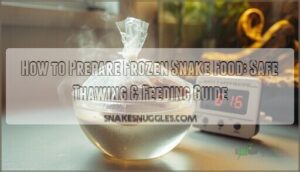This site is supported by our readers. We may earn a commission, at no cost to you, if you purchase through links.
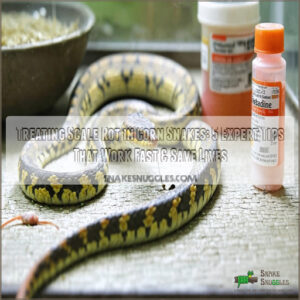
This bacterial infection is treatable when caught early.
First, move your snake to a clean quarantine enclosure.
Clean the affected areas daily with Betadine solution, followed by antibiotic ointment application.
Keep the enclosure dry and sanitized, maintaining humidity between 40-60%.
For severe cases with blisters or pus, you’ll need immediate vet care.
Just like treating a scraped knee, proper wound care makes all the difference – and there’s more to preventing future outbreaks than meets the eye.
Table Of Contents
- Key Takeaways
- Scale Rot Symptoms
- Treating Scale Rot
- Preventing Scale Rot
- Managing Scale Rot
- Scale Rot Care Tips
- Frequently Asked Questions (FAQs)
- Can a snake recover from scale rot?
- What antibiotic ointment is good for scale rot?
- What does corn snake scale rot look like?
- Does high humidity cause scale rot?
- How long until a snake fully recovers from scale rot?
- Can scale rot return after successful treatment?
- What temperature should corn snake enclosures be during treatment?
- Conclusion
Key Takeaways
- You’ll need to act quickly if you spot discolored or raised scales on your snake’s belly – move them to a clean quarantine enclosure and clean affected areas daily with Betadine solution followed by antibiotic ointment.
- You should maintain proper humidity levels between 40-60% and keep the enclosure clean and dry – high humidity and dirty conditions create perfect breeding grounds for the bacteria that cause scale rot.
- You’ll want to monitor your snake’s behavior closely during treatment – decreased appetite, unusual aggression, or lethargy can indicate worsening infection that requires immediate veterinary care.
- You must perform regular health checks by gently running your fingers along your snake’s body to feel for unusual bumps or texture changes – early detection significantly improves recovery chances, with 90% of early-stage cases making a full recovery.
Scale Rot Symptoms
You’ll notice scale rot in your corn snake when its scales become discolored or develop small blisters, especially on its belly.
If you spot raised scales with brown, yellow, or red patches that look different from normal shedding, it’s time to take action to address the discolored issue.
Discolored Scales
Under your corn snake’s belly, like a warning flag waving, discolored scales often signal the start of scale rot.
When checking your snake’s scale coloration, pay special attention to the ventral area, where color changes typically begin.
Excessive moisture, often due to improper humidity levels, can create a breeding ground for bacteria, leading to corn snake scale rot.
- Healthy pink belly scales turning an alarming muddy brown
- Greenish-black patches appearing above the tail region
- Yellowish discoloration spreading between scales
- Reddish marks forming irregular patterns
- Dark spots developing under previously clear scales
Blisters and Pus
Several tell-tale blisters might appear on your snake’s belly, signaling the onset of vesicular dermatitis.
These pus-filled blisters need swift infection control to prevent skin infection from spreading.
Proper environmental management is essential for preventing and treating this condition, as detailed in this guide to treating vesicular dermatitis.
You’ll notice these fluid-filled sacs can burst, releasing pus that requires immediate lesion treatment.
For effective blister care and wound healing during scale rot treatment, watch for multiple blister-like formations that demand prompt attention.
Elevated Scales
While those blisters might catch your eye first, raised scales often signal the next phase of scale rot in your corn snake.
Watch for patches of scales lifting away from your snake’s body like tiny umbrellas – this usually means infection’s brewing underneath.
You’ll notice these elevated scales creating an uneven, scaly texture, especially if they’re discolored or damaged, and quick infection control‘s imperative when you spot these skin lesions.
Behavioral Changes
Beyond the raised scales you’ve noticed, your corn snake’s behavior can tell you a lot about scale rot’s progression.
Watch for sudden lethargy, refusing to eat, or unusual aggressiveness – these are classic stress signs.
Early detection of scale rot is vital, so familiarize yourself with the symptoms and causes.
Snake activity typically drops, and you’ll spot social withdrawal as they hide more than usual.
If your normally food-motivated friend shows appetite loss or feeding issues, it’s time for a vet visit.
Treating Scale Rot
You’ll need to act fast when treating your corn snake’s scale rot, as this bacterial infection can quickly become serious if left untreated.
Starting with isolation and proper cleaning, you can save your snake‘s life by following the proven treatment steps that experienced snake owners and veterinarians recommend, which involves a careful approach to address the bacterial infection.
Quarantine and Isolation
Now that you’ve spotted those worrying scale symptoms, your first move is disease containment.
Following proper quarantine protocols, move your snake to a separate quarantine tank away from other reptiles.
Set up a simple quarantine enclosure with paper towels as substrate.
Keep biosecurity measures tight – maintain temperatures between 75-85°F and sanitize everything that touches your snake.
This isolation technique prevents spreading the infection.
Antibiotic Application
Anyone can tackle scale rot treatment with proper antibiotic application.
Here’s your step-by-step guide for treating scale rot effectively:
- Apply antibiotic ointment once daily using clean cotton swabs, avoiding eyes and mouth
- Wait 24 hours between applications to monitor healing progress
- Watch for signs of antibiotic resistance like worsening symptoms
- For severe bacterial skin disease, get prescription antibiotics from your vet
For more thorough treatment protocols, explore these ways to treat scale rot.
Keep the area clean and dry between treatments.
Soaking and Cleaning
Let’s build on those antibiotic treatments with proper soaking and cleaning – it’s like giving your corn snake a healing spa day.
Mix 1 part Betadine with 8-10 parts lukewarm water for a daily 20-30 minute soak.
You can find effective Betadine scale rot products online.
| Treatment Step | What You Need | Expert Tips |
|---|---|---|
| Daily Soaking | Betadine solution | Keep water lukewarm |
| Drying Process | Clean towels | Pat gently, don’t rub |
| Topical Care | Antimicrobial spray | Apply 3-4 times daily |
After soaking, pat your snake dry with paper towels and apply the antimicrobial spray to affected areas.
Preventing Scale Rot
You’ll save your corn snake from the misery of scale rot by keeping its home clean and dry every day.
Maintaining the right humidity level between 40-60% will help prevent scale rot. Removing any sharp objects that could harm your snake’s delicate scales will also help prevent it.
While treating scale rot can be challenging, you can prevent it.
Daily Enclosure Cleaning
In your daily snake enclosure cleaning routine, diligence is your best defense against scale rot. Your commitment to enclosure hygiene directly impacts your snake’s health. Thorough spot cleaning and waste removal keep your corn snake’s home pristine and disease-free. For a complete guide, explore best practices for snake enclosure cleanliness.
- Remove soiled substrate and waste immediately after spotting.
- Disinfect surfaces with snake-safe cleaners daily.
- Clean and refresh water bowls each morning.
- Check and sanitize hiding spots.
- Remove uneaten prey within 24 hours.
Daily cleaning and waste removal are essential.
Regulating Humidity
Maintaining ideal humidity levels for your corn snake requires careful monitoring and control. A digital hygrometer is your best friend for tracking enclosure humidity, which should stay between 40-50%. For convenient shopping, explore a wide selection of corn snake hygrometers.
| Humidity Control | Method | Effect |
|---|---|---|
| Too High | Add ventilation | Prevents scale rot |
| Too Low | Mist with water | Aids shedding |
| Just Right | Monitor daily | Healthy scales |
| Emergency | Quick fixes | Immediate help |
You can adjust moisture levels by using humidity-friendly substrates like cypress mulch or adding a water bowl near a heat source.
Secure Water Bowls
Smart bowl placement can make a world of difference in preventing corn snake scale rot. Your water bowl setup needs to hit all the right marks for proper snake enclosure hygiene.
- Choose heavy ceramic bowls to prevent tipping and spills
- Clean and refill bowls daily with fresh water
- Position bowls away from heat sources to control humidity levels
- Pick bowls 1.5x your snake’s coiled size for safe soaking
Balanced Diet
Proper food choices fortify your corn snake’s immune system against scale rot.
Beyond feeding mice, you’ll want to offer vitamin supplements and varied prey to meet their nutritional needs. Vitamin deficiencies, especially in A and C, can weaken their scales and make them vulnerable to infections.
Mix up their diet with properly gut-loaded mice and occasional supplements, following your vet’s recommendations for ideal snake health.
Managing Scale Rot
You’ll need to watch your corn snake closely during scale rot treatment to spot any changes in their health, from worsening symptoms to signs of recovery.
If you notice your snake’s condition isn’t improving after three days of home treatment, you should take them to a reptile vet right away.
Monitoring Health Progress
To effectively track your snake’s healing progress, you’ll need to keep detailed daily records of lesion improvement and overall recovery.
Watch for positive changes in appetite and activity levels, as these signal the treatment’s working.
For more details on the causes, symptoms, and treatment, check out this informative guide on understanding scale rot.
Monitor shedding patterns closely during wellness monitoring – they’re key indicators of skin health.
- Document any color changes in affected scales, from dark/infected to normal
- Track eating habits – a return to regular feeding is a great sign
- Note activity patterns – more exploration means they’re feeling better
- Check lesion edges for new, healthy scale growth
- Record shed quality and timing – complete sheds suggest healing
Addressing Underlying Causes
Your snake’s health tracker shows the root causes of scale rot need attention.
Check your environmental factors – corn snake scale rot often stems from poor humidity control and dirty substrate.
Boost your snake’s immune system with proper vitamins, and tackle skin damage early, like a leaky roof that needs fixing, treating scale rot means solving humidity issues and vitamin deficiencies in your snake’s home.
Reducing Septicemia Risk
Now that you’ve identified the root problems, let’s tackle keeping your corn snake safe from blood infections.
Scale rot can quickly turn into septicemia – a dangerous bacterial infection that spreads through your snake’s bloodstream.
- Keep the enclosure squeaky clean with daily disinfection rounds
- Treat any cuts or scrapes right away – they’re like open doors for bacteria
- Set up temperature zones between 75-85°F to boost your snake’s immune system
- Get rid of rough surfaces that could scratch your snake’s scales
The steps above will help shield your scaly friend from bacterial infections and create a safer space for wound healing.
Veterinary Care
When blood infections loom, your reptile veterinarian becomes your best ally.
A snake vet visit helps catch complications early through veterinary diagnosis and medical imaging, and your reptile vet can prescribe targeted antibiotics, perform necessary reptile surgery, and guide your snake’s rehabilitation.
They’ll also teach you prevention tricks that’ll keep your corn snake healthy long-term, which is crucial for the snake’s overall well-being, and for severe cases, don’t wait – emergency response matters, as it can significantly impact the outcome of the treatment, and working closely with your vet is key to a successful rehabilitation.
Scale Rot Care Tips
You’ll find that taking care of scale rot in your corn snake isn’t as scary as it seems, especially when you know the right steps to take.
With proper substrate selection, smooth enclosure surfaces, gentle handling techniques, and regular health monitoring, you can help your scaly friend recover quickly and prevent future infections.
Suitable Substrate Selection
The right substrate materials can make or break your corn snake’s recovery from scale rot.
You’ll want to choose between aspen bedding or coconut fiber – they’re both great at moisture control without promoting bacteria growth.
Skip reptile carpet or softwood shavings as they’re breeding grounds for trouble.
Forest floor bedding and Zilla Jungle Mix work well too, keeping humidity balanced while preventing scale issues.
Proper aspen snake bedding selection is vital for maintaining a healthy environment and preventing the recurrence of scale rot.
Smooth Enclosure Surfaces
While selecting proper substrate helps prevent scale rot, you’ll also want surfaces that won’t scrape your corn snake’s belly.
Here’s what works best for snake enclosure design:
- Smooth plastic or glass walls without rough edges or joints
- Polished ceramic tiles that stay cool and clean easily
- Non-abrasive climbing branches with sanded ends
- Rounded hide boxes without sharp corners
- Reptile-safe silicone sealant for any gaps
Check all surfaces regularly during cleaning to spot any wear that could harm your corn snake, and ensure the environment remains safe by using reptile-safe materials.
Gentle Handling
Beyond smooth surfaces, proper snake handling matters when dealing with scale rot.
Hold your corn snake with gentle, confident movements, keeping their body fully supported.
During treatment, minimize handling to prevent stress and additional scale damage.
When you need to handle them, use proper Snake Restraint techniques – support their whole body and avoid putting pressure on affected areas.
Think of it like carrying a fragile glass sculpture, which emphasizes the importance of gentle and proper snake handling.
Regular Health Checks
Weekly health monitoring acts as your first line of defense against corn snake health problems.
Regular scale inspection helps catch issues early, preventing serious reptile health issues like scale rot.
Your attentive snake observation can make all the difference in disease detection.
- Run your fingers gently along the body, feeling for unusual bumps or texture changes
- Check for discolored or raised scales, especially near the belly
- Monitor eating habits and weight – sudden changes need veterinary guidance
- Inspect around the mouth and vent for signs of infection
- Document observations in a health journal for tracking progress and spotting patterns
Frequently Asked Questions (FAQs)
Can a snake recover from scale rot?
90% of snakes with early-stage scale rot make a full recovery when treated promptly. You’ll need proper medication, cleaned enclosures, and adjusted humidity levels to help your snake heal completely.
What antibiotic ointment is good for scale rot?
For mild cases, apply silvadene cream or triple antibiotic ointment after cleaning with diluted Betadine.
Don’t use products containing pain relief or lidocaine.
Always consult your vet for the best treatment plan.
What does corn snake scale rot look like?
You’ll spot scale rot through discolored patches ranging from brown to red, along with raised or blistered scales.
Watch for crusty areas, especially near your corn snake’s belly, and any pus-filled swellings that appear.
Does high humidity cause scale rot?
Yes, consistently high humidity levels can trigger scale rot in your snake.
You’ll want to maintain 40-60% humidity and make certain there’s proper ventilation.
Excess moisture creates perfect conditions for harmful bacteria growth, which is why maintaining the right humidity level is crucial for preventing harmful bacteria.
How long until a snake fully recovers from scale rot?
Like watching a flower bloom, you’ll see healing unfold. Most cases show improvement within 2-3 weeks with proper treatment, but you’ll need patience as full recovery usually takes 4-6 weeks.
Can scale rot return after successful treatment?
Scale rot can definitely return if you don’t maintain proper humidity and cleanliness in your snake’s habitat.
Keep the enclosure clean, monitor temperature levels, and stick to good husbandry practices to prevent recurrence.
What temperature should corn snake enclosures be during treatment?
For ideal healing, maintain your enclosure’s temperature between 82-85°F during treatment.
You’ll want the basking spot at 88-90°F, while keeping the cool end around 75-78°F to prevent bacterial growth.
Conclusion
Picture your corn snake basking contentedly, scales gleaming with health once again.
By following these expert guidelines for treating scale rot in corn snakes, you’re not just addressing symptoms – you’re providing thorough care that guarantees your pet’s long-term wellbeing.
Remember to stay vigilant with enclosure maintenance, monitor humidity levels, and act quickly if you spot any concerning changes.
Your dedication to proper care today prevents serious health issues tomorrow, and when in doubt, always consult your reptile veterinarian.
- https://vetericyn.com/blog/how-to-treat-scale-rot-on-reptiles/
- https://www.petco.com/content/content-hub/home/articlePages/health-wellness/reptile-scale-rot.html
- https://www.wildlifedemonstrations.com/post/scale-rot-how-to-identify-and-treat
- https://www.justanswer.com/pet-reptile/mddy0-believe-snake-suffering-scale-rot-one.html
- http://veterinarymedicinejournal.usamv.ro/pdf/vol.LVIII_4/Art12.pdf


